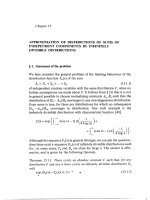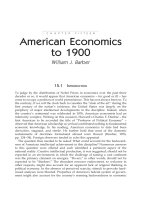Survey of accounting 6e chapter 15
Bạn đang xem bản rút gọn của tài liệu. Xem và tải ngay bản đầy đủ của tài liệu tại đây (1.75 MB, 35 trang )
Capital Investment Analysis
Chapter
15
©2013 Cengage Learning. All Rights Reserved. May not be scanned, copied or duplicated, or posted to a publically accessible website, in whole or in part.
Learning Objectives
After studying this chapter, you should be able to:
•
Explain the nature and importance of capital investment
analysis.
•
Evaluate capital investment proposals using the average
rate of return and cash payback methods.
•
Evaluate capital investment proposals using the net present
value and internal rate of return methods.
•
List and describe factors that complicate capital investment
analysis.
•
Diagram the capital rationing process.
©2013 Cengage Learning. All Rights Reserved. May not be scanned, copied or duplicated, or posted to a publically accessible website, in whole or in part.
Learning
Objective 1
Explain the nature and importance
of capital investment analysis
©2013 Cengage Learning. All Rights Reserved. May not be scanned, copied or duplicated, or posted to a publically accessible website, in whole or in part.
Capital Investment Analysis
• The process by which management plans,
evaluates, and controls investments in
_____________.
• Capital investment is very important for the
______________ success of a business.
©2013 Cengage Learning. All Rights Reserved. May not be scanned, copied or duplicated, or posted to a publically accessible website, in whole or in part.
Methods of Evaluating Capital
Investment Proposals
• Methods that do not use present value:
• _________________
• _________________
• Methods that use present values
• _________________
• _________________
©2013 Cengage Learning. All Rights Reserved. May not be scanned, copied or duplicated, or posted to a publically accessible website, in whole or in part.
Learning
Objective 2
Evaluate capital investment
proposals, using the average rate of
return and cash payback methods
©2013 Cengage Learning. All Rights Reserved. May not be scanned, copied or duplicated, or posted to a publically accessible website, in whole or in part.
Methods That Ignore Present
Value
• Often used to initially ________ proposals.
• Useful for proposals with relatively short useful
lives because the _________ of cash flows is
less important.
©2013 Cengage Learning. All Rights Reserved. May not be scanned, copied or duplicated, or posted to a publically accessible website, in whole or in part.
Average Rate of Return
• A measure of the average annual income
expected to be earned from the investment over
the investment life, after deducting depreciation.
• Also called the accounting rate of return.
Avg. Rate of Return =
©2013 Cengage Learning. All Rights Reserved. May not be scanned, copied or duplicated, or posted to a publically accessible website, in whole or in part.
Average Rate of Return
•
•
•
•
Cost = $500,000
No Residual Value
4-year useful life
Estimated total income - $200,000
Avg. Rate of Return =
$
$
©2013 Cengage Learning. All Rights Reserved. May not be scanned, copied or duplicated, or posted to a publically accessible website, in whole or in part.
Average Rate of Return Analysis
• If the average rate of return equals or exceeds
the company’s minimum rate, the project should
be __________.
• Advantages:
• Easy to compute.
• Includes the entire income to be earned over
the life of the proposal.
• Emphasizes accounting income.
• Disadvantage – does not directly consider the
_____________and _______________.
©2013 Cengage Learning. All Rights Reserved. May not be scanned, copied or duplicated, or posted to a publically accessible website, in whole or in part.
Cash Payback
• The cash payback period is the expected period
of time between the date of an investment and
the complete recovery in cash (or equivalent) of
the amount invested.
• The excess of cash flowing in from revenue over
the cash flowing out for expenses is called net
cash flow.
Cash Payback Period =
©2013 Cengage Learning. All Rights Reserved. May not be scanned, copied or duplicated, or posted to a publically accessible website, in whole or in part.
Cash Payback
• Cost = $200,000
• Estimated cash inflow per year = $50,000
• Estimated cash outflow per year = $10,000
Cash Payback Period =
$
$
©2013 Cengage Learning. All Rights Reserved. May not be scanned, copied or duplicated, or posted to a publically accessible website, in whole or in part.
Cash Payback
• If annual cash flows
are not equal, the
payback period is
determined by
adding the
_______________
until the investment
is recovered
©2013 Cengage Learning. All Rights Reserved. May not be scanned, copied or duplicated, or posted to a publically accessible website, in whole or in part.
Cash Payback Analysis
• Advantages:
• Used for evaluating ___________ proposals.
• A short payback period is desirable.
•The sooner the cash is recovered, the sooner it can
be reinvested.
•There is less chance of losses from changing
economic conditions.
• Disadvantages:
• Ignores ___________ after the payback period.
• Does not use present value concepts.
©2013 Cengage Learning. All Rights Reserved. May not be scanned, copied or duplicated, or posted to a publically accessible website, in whole or in part.
Learning
Objective 3
Evaluate capital investment proposals
using the net present
value and internal rate of return
methods
©2013 Cengage Learning. All Rights Reserved. May not be scanned, copied or duplicated, or posted to a publically accessible website, in whole or in part.
Present Value Considerations
• Uses both the amount and timing of _________
to evaluate an investment.
• Present Value of an Amount – $1 today is worth
______ than $1 received in a future date,
because today’s $1 can be invested and earn
interest.
• Present Value of an Annuity – sum of the present
values of a series of equal cash flows at
__________ intervals.
©2013 Cengage Learning. All Rights Reserved. May not be scanned, copied or duplicated, or posted to a publically accessible website, in whole or in part.
Time Value of Money
©2013 Cengage Learning. All Rights Reserved. May not be scanned, copied or duplicated, or posted to a publically accessible website, in whole or in part.
Present Value Calculations
• Present value tables help us calculate
present values for _________ and
___________.
Exhibit
1: Partial Present Value of $1 Table
©2013 Cengage Learning. All Rights Reserved. May not be scanned, copied or duplicated, or posted to a publically accessible website, in whole or in part.
Present Value of an Annuity
Calculations
• Cash Inflow Timeline and Present Value
©2013 Cengage Learning. All Rights Reserved. May not be scanned, copied or duplicated, or posted to a publically accessible website, in whole or in part.
Present Value of an Annuity
Calculations
• Present value tables help us calculate present
values for ___________ and __________.
Exhibit 2: Partial Present Value of an Annuity Table
©2013 Cengage Learning. All Rights Reserved. May not be scanned, copied or duplicated, or posted to a publically accessible website, in whole or in part.
Net Present Value Method
• Analyzes capital investment proposals by
comparing the initial cash investment with the
_______________ of the net cash flows.
• Also called ____________ cash flow method.
• The return rate is set by management – often
called the _________ rate.
• If the net present value expected from an
investment equals/exceeds the initial investment,
the project is __________.
©2013 Cengage Learning. All Rights Reserved. May not be scanned, copied or duplicated, or posted to a publically accessible website, in whole or in part.
Net Present Value Calculation
• Net present value
analysis for the
purchase of a
$200,000 machine
with a 5-year useful
life. Minimum rate of
return is 10%.
©2013 Cengage Learning. All Rights Reserved. May not be scanned, copied or duplicated, or posted to a publically accessible website, in whole or in part.
Present Value Index
• If ___________are being considered, use of the
present value index can help determine which
projects to accept.
Present Value Index =
©2013 Cengage Learning. All Rights Reserved. May not be scanned, copied or duplicated, or posted to a publically accessible website, in whole or in part.
Internal Rate of Return
• Uses present value concepts to compute the
_____________from the net cash flows
expected from capital investment proposals.
• Also called the ______________________
method.
• Starts with net cash flows and works backward
to determine the ____________expected from
the project.
©2013 Cengage Learning. All Rights Reserved. May not be scanned, copied or duplicated, or posted to a publically accessible website, in whole or in part.
Internal Rate of Return
•
•
•
•
Cost = $33,350
Estimated cash inflow = $10,000
Expected life – 5 years
Rate of return – 12%
Exhibit 3: Net Present Value Analysis at 12%
©2013 Cengage Learning. All Rights Reserved. May not be scanned, copied or duplicated, or posted to a publically accessible website, in whole or in part.









